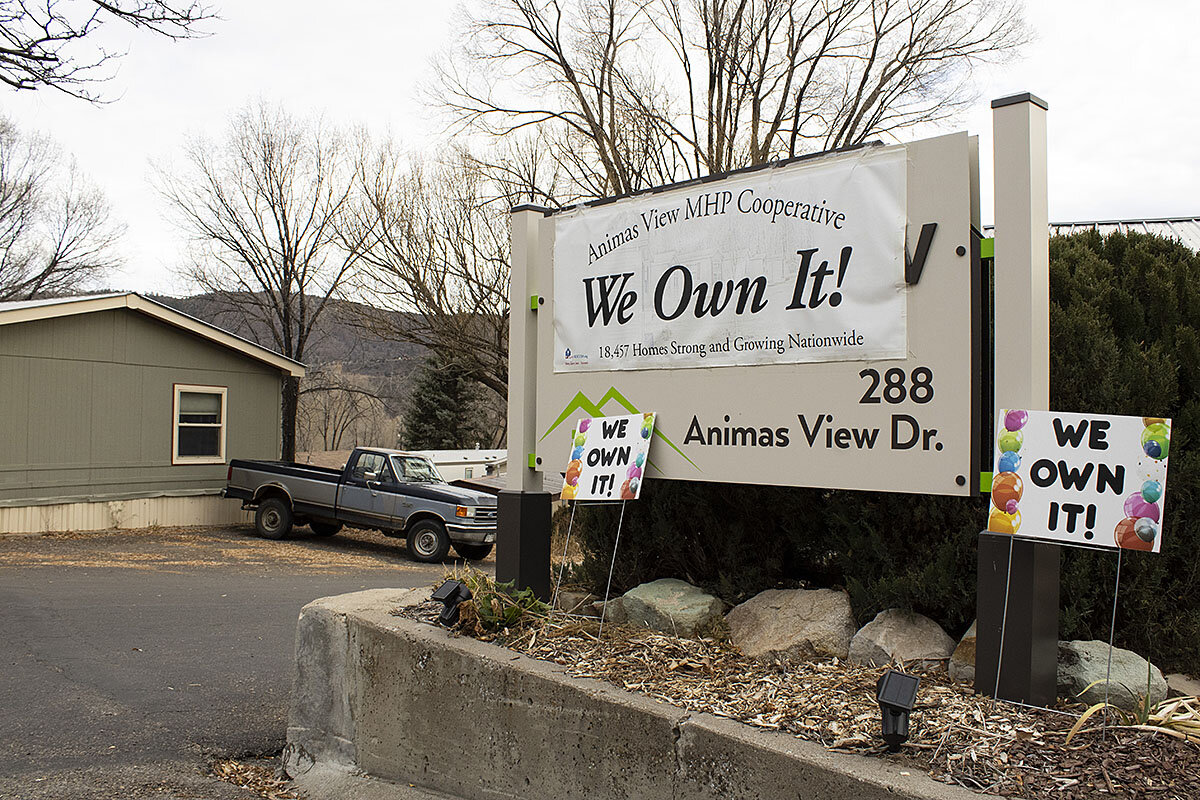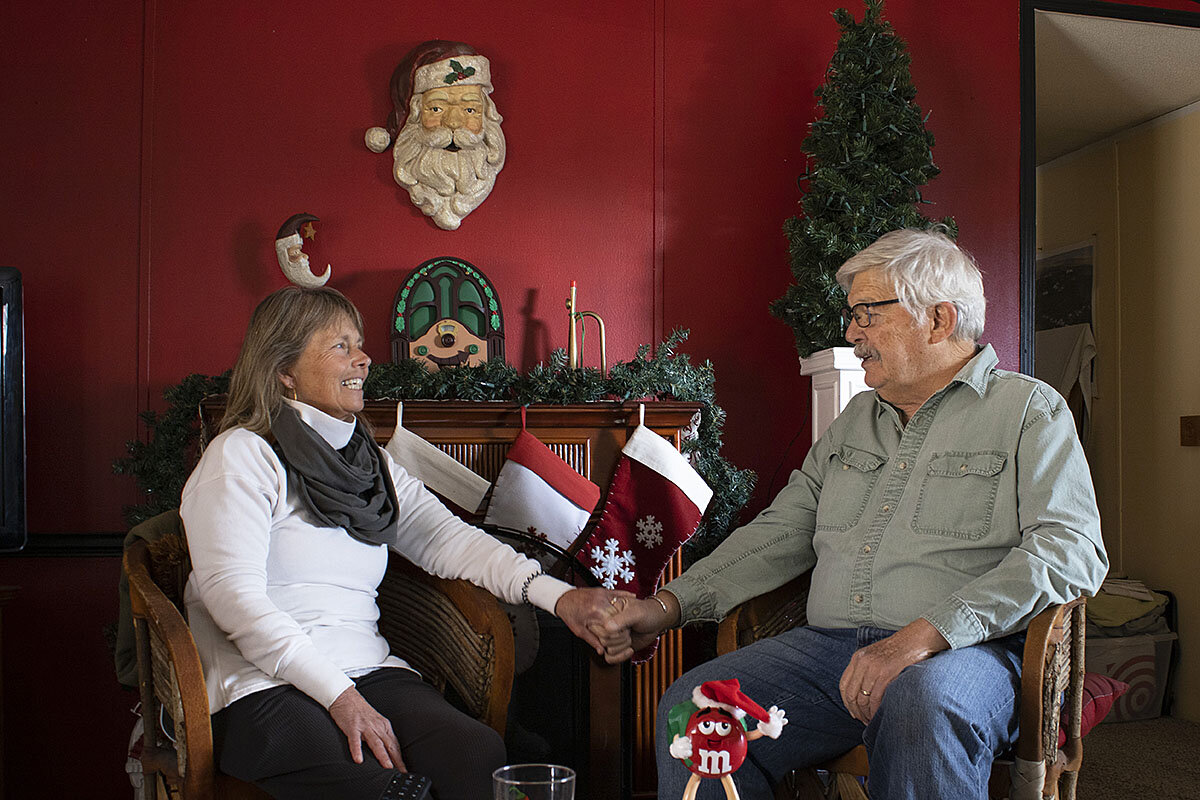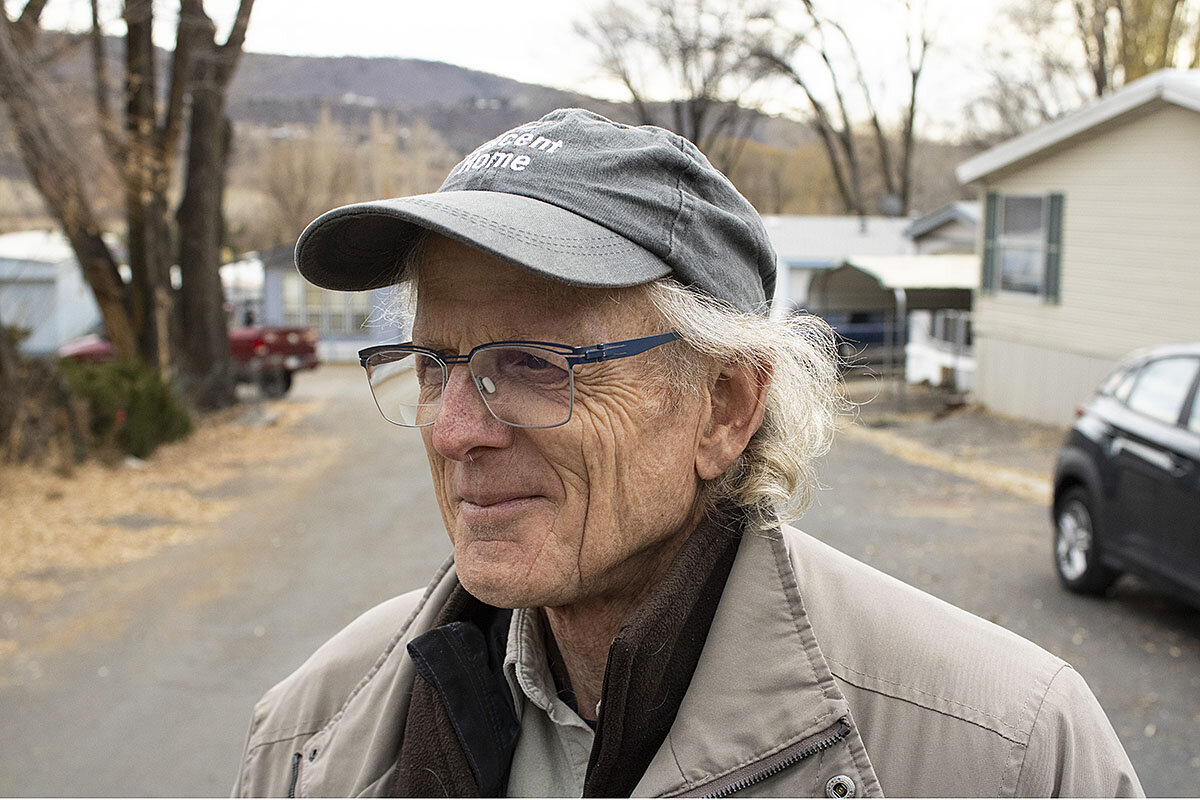No landlord: Mobile home community finds stability in self-government
Loading...
| Durango, Colo.
One sunny, cold morning last January, John Egan joined fellow mobile home park residents on a neighbor’s front porch. They needed to organize. But how?
“I had to go to the restroom, and when I came back from the restroom, they said, ‘Hi! You’re president!’” recalls Mr. Egan.
The half-dozen folks had convened to think through how to buy their Durango, Colorado, park from the private landlord – a move Mr. Egan and others deemed a shot in the dark. But now they at least had a president for what would become an interim board. With guidance from a housing nonprofit and majority support from the community, residents succeeded in purchasing the roughly 15-acre property within five months. They celebrated with a picnic, as the new Animas View MHP Co-op joined some thousand other resident-owned communities countrywide.
Why We Wrote This
For some mobile home park residents, a stable home comes with self-government. In one case in Colorado, it brought a stronger sense of community too.
Their achievement is unusual. The resident-owned market constitutes just 2.4% of manufactured housing communities nationwide. Bolstering the health and longevity of mobile home parks is important as they are a critical source of affordable housing, say industry experts. Recent legislation in Colorado offers some provisions for communities like Animas View that hope to secure their future by governing themselves.
“Everybody sleeps better at night,” says Steve Boardman, here for 20 years, as he takes out his recycling.
“We’re in control.”
Affordable homes with a view
River, mountains, grasses bleached blonde in autumn – the Durango mobile homes have a million-dollar view. Largely immobile and costly to move, these factory-built units have been commonly called “manufactured homes” since 1976. They house an estimated 18 million to 22 million people in the United States.
“This is one of our nation’s largest sources of deeply affordable housing, and it’s deeply affordable without any federal subsidy,” says associate professor of sociology Esther Sullivan at the University of Colorado Denver.
The median annual household income of these homeowners – $35,000 – is half that of site-built homeowners, according to Fannie Mae. Manufactured housing fills 6.3% of U.S. housing stock, with more than double that share in rural areas.
Many residents own their homes but not the underlying land, for which they pay “lot rent.” That model can spur financial precarity: These homeowners are “more likely to see their homes depreciate and have fewer protections if they fall behind on payments,” reports the Consumer Financial Protection Bureau.
Media reports have increasingly shed light on private-sector purchases of these parks that often result in rent increases, which housing advocates deem predatory.
Mobile home park investor Frank Rolfe counters: “When we buy these properties, they’re often in terrible condition, and [we] bring them back to life. … You can’t bring old properties back to life without raising rents.”
Mr. Rolfe estimates that he and a partner are the fifth largest owners of U.S. mobile home parks. “There is this conception I think out there that park owners are in some way hostile to residents buying their own communities, and that is completely off base,” says Mr. Rolfe, co-founder of Colorado-based Mobile Home University, which trains investors to purchase parks. Three parks he co-owned have been sold to residents.
No more landlords
Mr. Egan and his wife, Cate Smock, bought their trailer here in 2012 – an affordable move to Durango so their son could attend a better school. But afterward, they saw their lot rent, which includes utilities, increase annually, if not twice a year.
“You would dread the piece of paper with the black electrical tape on your door,” she says. Animas View residents also complained of the previous owner’s lack of attention to their needs and delayed repairs.
Shortly before Christmas 2020, residents learned that the latest landlord, Strive Communities, intended to sell. Residents began to organize almost immediately. (The Monitor could not reach Strive for comment.)
“We don’t tell people that it’s easy” to become resident-owned, says Mike Bullard, communications and marketing manager for ROC USA, a New Hampshire nonprofit that, along with its affiliates, reports having helped nearly 300 manufactured housing communities become resident-owned. (ROC stands for resident-owned communities.)
With 430 households, the Halifax Mobile Home Estates Association in rural Massachusetts is the largest in the ROC USA network, resident owned since 2017. The budget is tight due to the community’s size, says board president Deborah Winiewicz, but at least members have a say in how those funds are spent by voting at an annual meeting.
“We’ve found, too, that people take more pride in the community because it is theirs,” she adds, noting that their sales office is run by resident volunteers.
In Colorado, the network affiliate Thistle ROC helped the Durango cooperative patch together funding for their purchase. But to afford the financing, the co-op increased lot rent by $80 this fall (rent ranges between $755 and $825). While the uptick may seem counterintuitive, it’s not uncommon, says Mr. Bullard.
“These groups are buying not just the real estate, but the business,” he says, adding that lot rent for new resident-owned communities will typically drop down to market rate or below within five years.
The sale, first reported by The Durango Herald, closed in June for a purchase price of around $15 million, according to Dan Hunt, a former Animas View board member who now serves on the operations and finance committees.
Learning about the community’s grassroots organizing helped convince Kevin Miller to rent land there for his RV. Now board president, Mr. Miller, who moved in last year, says he likes the idea of keeping money within a community.
“I’m proud to tell people where I live now,” he says.
Progress from failure
Among legislation aimed at strengthening protections for mobile home dwellers, Democratic Gov. Jared Polis signed a bill into law in 2020 that requires landlords to provide residents at least 12 months’ notice of a potential change in use of the land. It also gives residents 90 days after being notified by the landlord of a potential sale of the park to pitch an offer to purchase and organize financing. Landlords must respect this “opportunity to purchase” window before selling to anyone else.
But the resident-owned model is still the exception, not the rule. Animas View is one of three parks to become resident owned in Colorado in 2021, out of a few dozen that changed ownership.
Still, the new legislation “gives [residents] the opportunity to be able to compete with an offer that they previously wouldn’t have known about,” says Andy Kadlec, program director at Thistle ROC.
Advocates say this legislative momentum grew out of the activism and unsuccessful attempt by residents of another Colorado mobile home community, Denver Meadows, to purchase their park ahead of its expected closure as the owner eyed redevelopment. Despite help from advocacy group 9to5 Colorado and Thistle ROC, the Aurora-based community’s purchase offer in 2017 was reportedly rejected. Though some homeowners received relocation assistance, many ended up paying double rent elsewhere, says Cesiah Guadarrama Trejo, 9to5 associate state director.
The Denver Meadows saga was featured in the 2021 mobile home documentary “A Decent Home” by filmmaker Sara Terry, a former Monitor journalist. Her team arranged an event in Colorado this November that connected manufactured housing homeowners from across the country with activists, policy experts, and former Denver Meadows residents.
Reflecting on when she started the film six years or so ago, Ms. Terry notes, “I had to say the ‘underreported’ affordable housing crisis. … [Now] people are paying attention. I think grassroots activism is flourishing, and that makes me hopeful.”
Mr. Hunt, one of a few Animas View residents who attended the gathering, says he went up to a displaced Denver Meadows man and thanked him.
No threat of eviction
Just beyond the limits of the Durango park, a train slices through the mountain view with a harmonic huff. Current and former board members are keen to keep this community intact, and, so far, residents report no one has moved out since the sale.
“One of the first things that we decided when we met as a board was that we would not allow anybody to be forced out of the park because of an inability to pay the rent,” says former board president Mr. Egan in his home, where Christmas stockings hang above an electric fireplace.
To ensure folks can afford to stay, the community is developing a rental assistance fund. In addition to seeking outside funding, some residents plan to donate spare dollars themselves. Lindie Hunt, board treasurer and Mr. Hunt’s wife, recently jump-started the fund with a check for $60 – a sum she’d been given for checking on a neighbor’s home while they were away.
“It wasn’t my money in the first place,” she reasons in her kitchen, preparing to leave for work one morning.
Beyond paying off the five initial loans, the 120-lot community faces infrastructure projects, such as a wholesale water and sewer system replacement. To help keep maintenance costs down, several residents volunteer their time and skills. Mr. Boardman wields a weed wacker sometimes.
Needing to collaborate, residents have also begun to get to know their neighbors better. Surrounded by sawdust and screws, Kirby MacLaurin and Doug Harris are voluntarily tearing up a duplex that the co-op hopes to renovate into a rental.
Though they’ve overlapped at Animas View for a few years, the men just met.
“Ever since we made the co-op, we are meeting each other for the first time. Isn’t that amazing?” says Mr. Harris.
“It’s true,” says Mr. MacLaurin, hammer in hand. “Best buds … what a find.”









